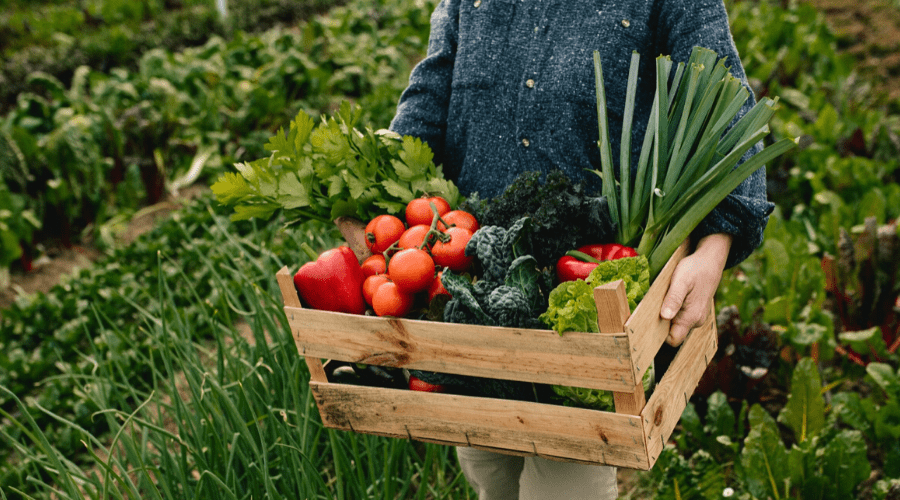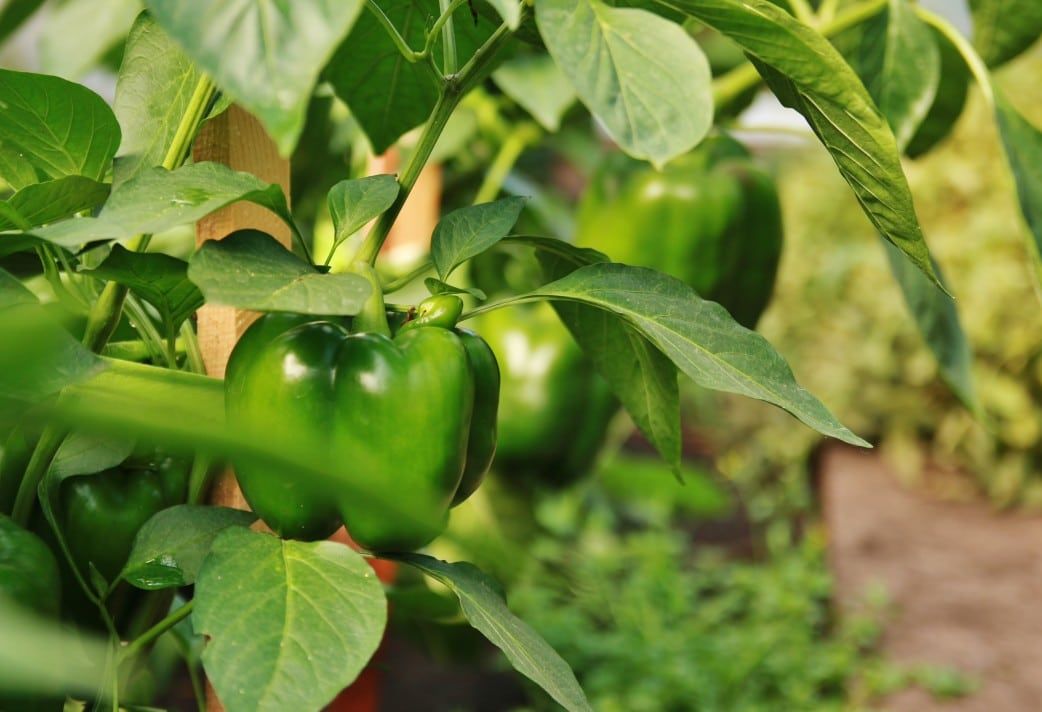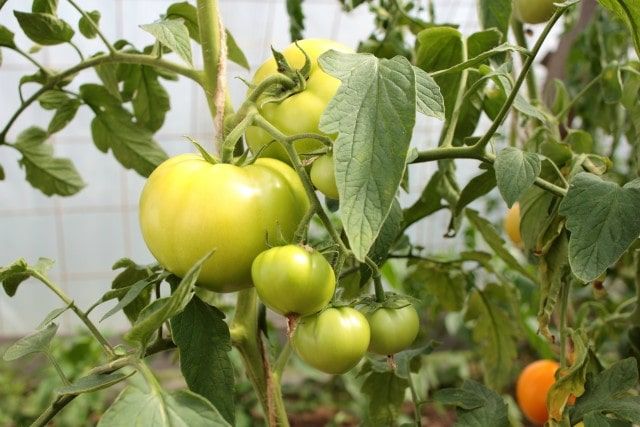So you love the idea of gardening.
You love the beauty of twisting vines and bulging produce.
You love telling your friends about how successful your squash is and what prizewinners your potatoes are.
You love the delicious produce, steps away from your kitchen.
What you hate, is the work. The long days spent outside, the sun beating at your back and mosquitoes biting at your ankles. The weeds with more incarnations than the Terminator. The plants that never seem to grow right, or sometimes at all.
You are in the right place.
This list contains 15 easy vegetables to grow in your backyard garden. These simple garden vegetables require minimum effort, few skills, and little gardening know-how, but produce bountiful harvests.
Easy Vegetables to Grow for Beginners
Potatoes
Potatoes are not a picky plant, but they are easy to grow.
The preferred time for starting to grow potatoes is a few weeks after the last frost; however, you can really grow them whenever. They can also grow wherever. In a raised garden bed, the Four Seasons of potato vessels, a large pot, the Holiday Inn of potato vessels, or a garbage bag full of soil, the Motel 6 of potato vessels.
Potatoes are not only flexible in their ability to thrive in many conditions, they also can grow numerous other potatoes from something as small as a potato scrap. Plant the scrap in the soil, cover it adequately, water it regularly, and it will produce a bountiful harvest.
Potatoes, unless they are fried, are a great source of nutrients. Eating a potato with the skin on can supply you with all the nutrients you need for the day. Interestingly, potatoes even contain more potassium than bananas. Hungry for more potato fun facts?
Peppers
This spicy fruit is on fire when it comes to how easy it is to grow.
Peppers are very low-maintenance and make an excellent container plant. You can grow all kinds of peppers--bell peppers, jalapeno peppers, banana peppers--indoors on your windowsill. Just make sure that their container is full of soil that easily drains and contains organic matter, and that they are in a spot with a lot of sunlight.
Once you plant your peppers, continue to water them frequently, and in 2-3 months you will have produce. Hot peppers can take as long as 5 months.
Peppers are also awesome companion plants. They specifically thrive when grown with basil and parsley; however, peppers are self-pollinators so they actually do not need other plants to grow. Bell peppers have incredible benefits like boosting your immune system, supporting weight loss, and improving eye health.
The chemical compound capsaicin, which is found in spicy peppers, can aid weight loss by raising your body temperature, causing your body to use more energy and increasing your metabolism.
Green Beans
Green beans have quickly become one of the most common vegetables to grow in gardens. This quick rise to fame was fueled by them being quick to produce edible growth. It only takes two months for green beans to be ready to harvest.
Not only is their growth fast, once you plant them they will continue to steadily reproduce. You can harvest green beans frequently. This will not only continually supply you with delicious green beans to eat but will also promote the growth of more green beans on your plant.
So you can grow your vegetables and eat them too!
Soak your green beans in warm water for one day before planting them to speed up their already fast germination process. The soil you plant them in should be at least 65°F, well-draining, and nutrient-rich, preferably with organic fertilizer.
Green beans can boost your immune system, heart, and eye health. Green beans are low in fat and cholesterol, but high in fiber. They contain vitamins A, C, K, and B6, and minerals like calcium, iron, manganese, and potassium.
Tomatoes
Tomatoes are one of the most popular vegetables to grow in America. This is because they are hearty plants and absolutely delicious.
The most difficult part about growing tomatoes is deciding which type you want to grow. There are over 25,000 types of tomatoes to choose from! If you get a determinate tomato plant it will be extremely easy to manage: determinate tomato plants will only grow to a specific, predetermined height.
You can easily plant determinate tomatoes in containers. Make sure the soil you plant them in is nutrient-rich, and that you water tomatoes regularly. Tomatoes, especially those grown in containers, are very thirsty plants.
Basil, chives, mint, and sage are great companion plants to plant near tomatoes. Plus, you can use the basil with the tomatoes to make a Caprese salad after you harvest them.
Tomatoes are technically fruits, however, the nutrition they supply is more similar to vegetables. They contain a large amount of vitamin C, vitamin A, and vitamin K, and are high in potassium.
Broccoli
Broccoli is not only tasty and nutritious, it is also is fairly easy to grow.
It requires very little care throughout its growing cycle. Additionally, it's common for broccoli to not just yield one crop a year, but rather, two. That means that for very little work you will get two harvests of broccoli.
If that doesn’t appeal to a lazy gardener, I don’t know what does.
Broccoli is a hardy plant, which is what makes it good for beginners. It can thrive in soil that is as low as 20°F but grows better in temperatures between 45°F to 75°F. Plant your broccoli in a spot with full sunlight, in soil that is rich, full of organic-material, and fertilized. You have to water your broccoli plant frequently because it requires moist, soggy soil.
Broccoli is one of the healthiest vegetables on Earth. It is full of antioxidants which reduce inflammation and cellular damage and boost human health.
Carrots
Can’t you see? Carrots are a great vegetable to grow!
Carrots are not only delicious, they also include necessary nutrients for eye health, including beta-carotene, lutein, and zeaxanthin.
They are a very easy vegetable to grow as long as you know the proper way to care for them. The biggest grievance growers have with carrots is that sometimes there can be deformities in growth, however, this issue can be attributed to them being planted in rocky, nutrient-poor soil. If you plant your carrots in a sandy soil that drains well and water them regularly, you should have very few problems with their growth and harvest. A great way to mitigate this problem is to micromanage the soil by planting carrots in containers.
Carrots can handle some cold weather, although they prefer temps between 60°F- 70°F.
Pumpkins
While jack-o-lanterns may be scary, planting pumpkins is not!
Pumpkins are a fool-proof plant: if you plant their seeds in a remotely correct way, they will grow.
Plant a few seeds an inch deep into nutritious soil that is at least 70°F. Pumpkins love the warmth and love sunlight, so they need to be in a spot that gets at least 6 hours of sun each day.
You have to frequently water pumpkins, thoroughly drenching the soil around them. You also have to ensure that your pumpkins are getting enough pollen because they rely on pollen to successfully grow. To ensure this, consider hand-pollinating them or planting thyme, sage, or mint as companion plants because they attract pollinators.
Plant your pumpkins in the summer so they are ready for Halloween and Thanksgiving. Pumpkins are scary good at keeping your body healthy. They have an extremely high vitamin A content. Vitamin A can improve your vision, immune system functioning, and rate of cell growth.
Sweet Potatoes
Sweet potatoes may not be the easiest vegetable on this list, but they sure are one of the tastiest!
Who isn’t sweet on sweet potatoes?
Sweet potatoes, unlike other vegetables, must be grown from slips. Slips are shoots within a mature sweet potato. You first have to prepare the slip sprouts by placing them half in a glass of water and leaving them in the sun for a few weeks.
You can then move them to your garden, but make sure that the soil is loose and well-drained before you plant.
Once all of the slips are planted, water them, soaking them and the surrounding dirt. Sweet potatoes love water but can survive without it, withstanding droughts. However, when they are under-watered they produce less.
Sweet potatoes are loaded with beta-carotene and vitamin A. Beta-carotene promotes skin, vision, and respiratory health.
Mushrooms
Why did you invite mushrooms to the vegetable party?
Because they are a fun guy!
While that joke may have been unpalatable, mushrooms are not. They are extremely delicious and easy to grow. If you are a beginner grower, a great option for growing them is a mushroom growing kit. Mushroom growing kits require almost no skills, experience, or tools. The only thing that you need is the kit itself.
Root Mushroom Farm Growing Kit
Everything you need to grow mushrooms. There are different kits for King Oyster, Shitake, or Cordyceps Militaris.
If you choose to grow mushrooms from spores or spawn, it can also be a fun and simple process, requiring a cool, dark, damp place to grow the mushrooms. You will need to initially heat them for a few weeks so that the spores can take root, establishing an ability to grow. After a few weeks, cover the mushrooms with potting soil and a damp cloth. Spray the cloth whenever it dries out for the next month.
By the end of the month, you should have the beginnings of mushrooms!
Mushrooms are not only tasty, they are also good for you, having a high selenium content, which supports your immune system and prevents cell and tissue damage.
Onions
Don’t start crying, onions are included on this list.
Save those tears when you have to cut your freshly harvested backyard onions.
There are three simple options for growing onions; they can be planted by seed, transplant, or sets. Onion sets are by far the simplest way to grow onions. Merely plant the bulbs in your garden, keep the soil evenly moist around them, and make sure that they are getting adequate sunlight. Make sure to pull weeds from around the onions, mulch, and fertilize every couple weeks.
Before you know it you will be able to harvest your very own, homegrown onions.
Onions are great to eat because they are absolutely packed with nutrients and antioxidants. They can boost your heart health, bone density, and digestive capabilities. Green
Garlic
The smell, the taste, there is so much to love about garlic.
Garlic is an incredible food.
What is really incredible, though, is how easy it is to grow.
You can easily grow garlic sprouts in your home with nothing more than a container, water, and garlic.
Fill a container with water, fully covering the bottom, but not much more than that. Take a garlic clove that is already sprouting and place it in the container so its bottom is just touching the water. Leave it in a sunny spot. Make sure you change the water frequently, whenever it looks murky or cloudy.
That’s it!
Before you know it you will be able to harvest garlic sprouts to put in your food.
Garlic sprouts, in particular, have powerful health benefits. Sprouts that have grown out for five days have some of the highest antioxidant levels of any vegetables, by far surpassing the antioxidant levels of normal garlic.
Zucchini
Who doesn’t love zucchini?
Take how much you love zucchini and multiply that by 10. That is how much you will love homegrown zucchini.
To successfully grow zucchinis you need to plant seeds 3-6 feet apart from each other in nutrient-rich soil that is well-composted. Hill the zucchinis, meaning surround them with other zucchini plants. Plant them in a sunny spot, after warm weather hits.
Zucchinis abhor the cold.
Other than their dramatic dislike for the cold, zucchinis are very low-maintenance plants. For the lack of work you will need to put in, it will blow your mind how many zucchinis you will harvest. This green veggie is a prolific producer.
Cucumbers
Plant cucumbers in rich soil with a high nitrogen content in a sunny spot next to a fence. If such a miraculously perfect spot is available in your yard, your cucumbers will thrive, using the fence as a shelter and place for vines to crawl up.
Cucumbers can be tricky to grow in containers because they require huge pots and must be placed in a very sunny spot; however, if you are committed to container gardening, it is possible. Water them frequently.
Cucumbers are a great source of hydration for the body. Water is crucial to bodily functions like temperature regulation and digestion, and impacts your ability to perform physically and intellectually. You can get up to 40% of your daily water intake from food. Cucumbers are 96% water.
Squash
Squash is a hardy, heat-loving plant.
Plant squash in organic-matter-containing, loose, moist soil after the last frost. Configure the seeds in hills with 4-5 seeds per hill that will be thinned down to a few plants. Make sure that you regularly water the plants and that you heavily mulch them.
It takes a couple of months for squash to fully mature. They are well worth the wait though, the taste of homegrown squash is unparalleled.
Squash also has natural immune system boosting properties. Squash seeds are an incredible multi-purpose remedy, creating antiparasitic, antimicrobial, and antifungal activity in your body.
Lettuce
Lettuce is a very chill, cold weather plant.
It thrives in cold weather so plant it either in the fall or the spring. Lettuce seedlings are hardy so they can survive through some frost.
Being a prolific grower, small crops of lettuce will keep producing for months. That means salad bowl after salad bowl for you!
That is if the pests don’t get to your lettuce.
To help ward them away, consider planting garlic and chives with it as companion plants.
Lettuce is very useful for people with sleep problems. It contains lactucarium which helps you relax and increases your sleep quality. It has a similar chemical structure to opium and shares some properties with it. Fortunately (or unfortunately, maybe), lettuce is not addictive.
Container Gardening
Just because you are growing easy garden vegetables does not mean that they have to be in your garden. It is easy to grow vegetables, fruits, herbs, everything, in containers.
Container gardening is ideal for someone who doesn’t have an established garden yet or doesn’t have lawn space to create one. You can sit your container on your balcony, patio, or even indoors. Your container can be a pot, pan, barrel, or anything, depending on how large your plant will grow.
What is necessary is that your container does have drainage holes so that water can run through your plant’s soil. What container you use, and where you put it, will largely depend on what kind of plant you are growing within it. A container that is 1.5 feet tall will work well for most vegetables.
Containers also have the benefit of creating a weed-free environment, unless you are filling them with soil from your garden.
Easy Herbs to Grow
A great place to start gardening is with herbs. They are extremely resilient and easy to take care of. They also can make great companion plants for vegetables and will add extra flavor to the dishes you make with your newly harvested veggies.
Consult the list below for some easy-to-grow herbs!
- Basil
- Parsley
- Chives
- Mint
- Oregano
- Rosemary
- Sage
- Thyme
- Cilantro
Conclusion
I hope this guide to the easiest vegetables to grow helped you decide what you want to plant this season. Of course, all of the above options are incredible, so I do understand if I have just made the choice more agonizing.
If you enjoyed this article be sure to share and comment below!












